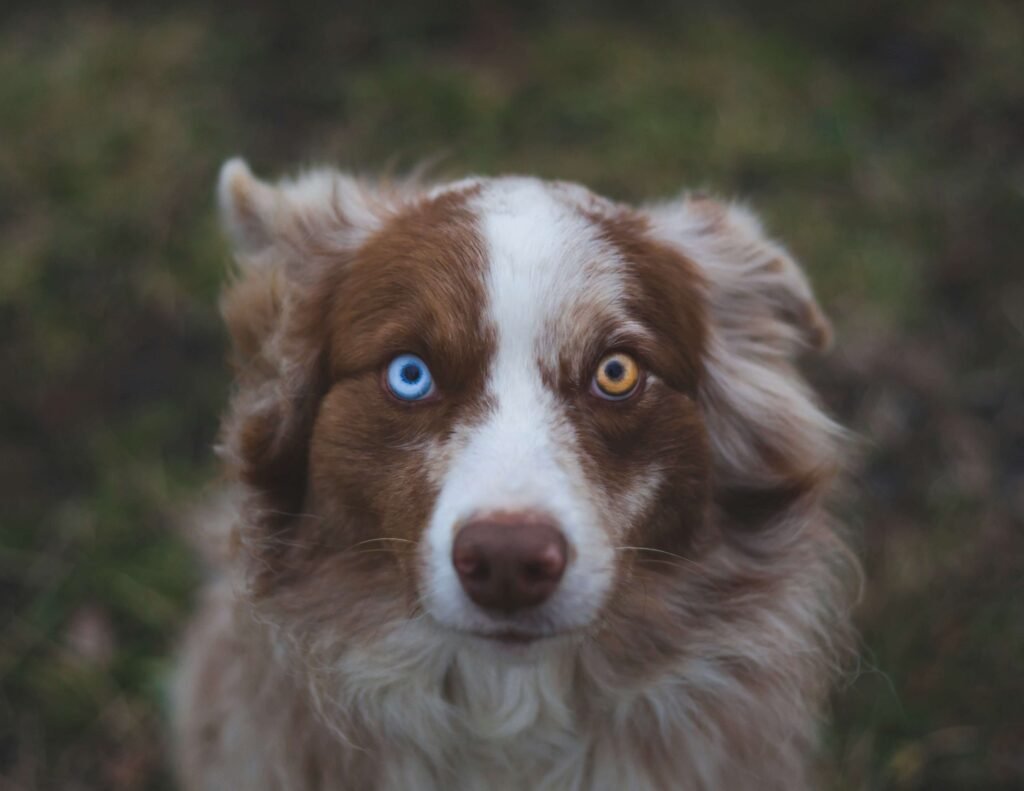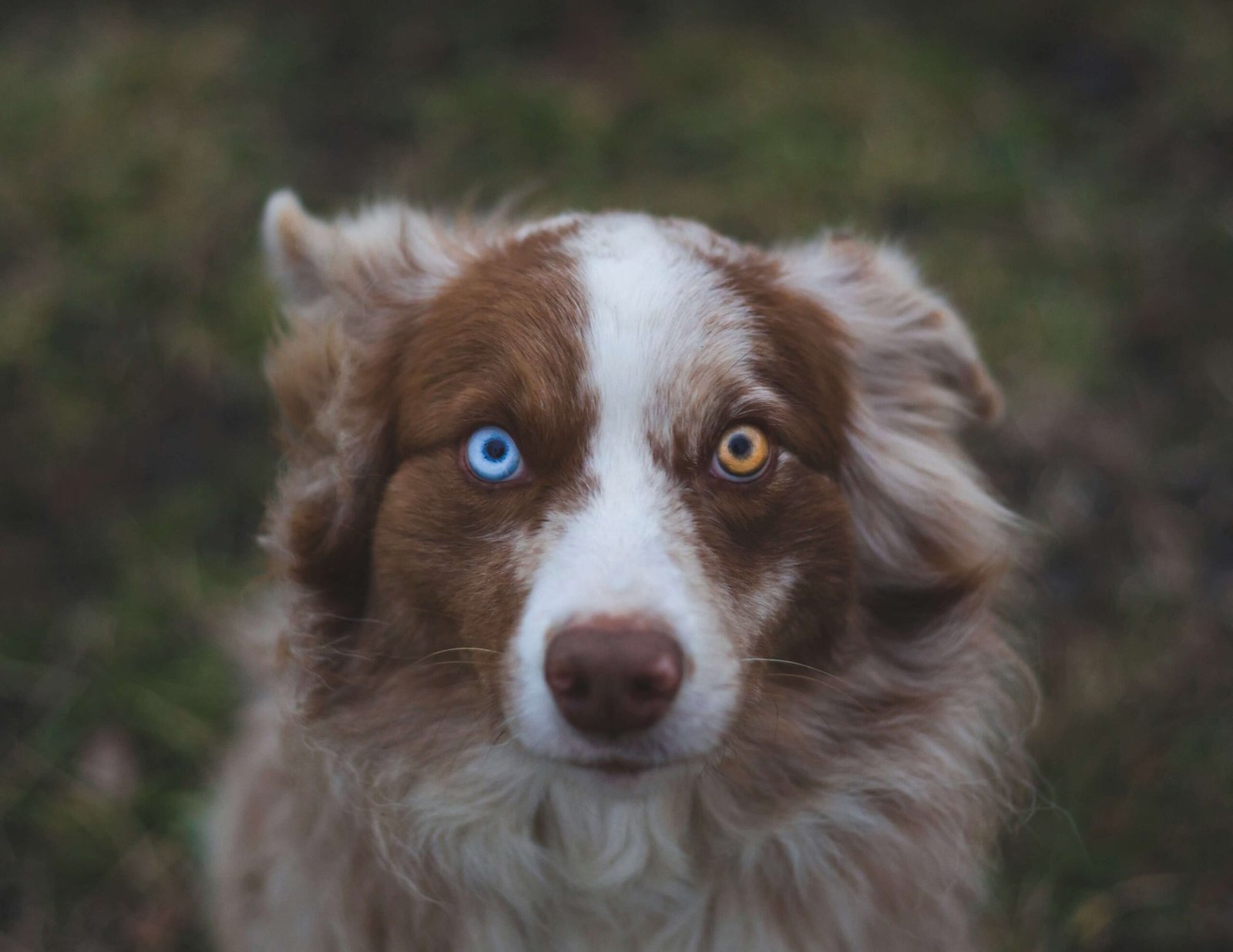The Beauty of Heterochromia in Dogs
Dogs have always been known as man’s best friend, but some canines take this companionship to a whole new level with their mesmerizing eyes. One such captivating trait is heterochromia, a condition where a dog has two different-colored eyes. This unique feature not only adds to the charm of our furry friends but also sparks curiosity among dog lovers and owners alike. Whether it’s a Siberian Husky with piercing blue and brown eyes or an Australian Shepherd with strikingly mismatched irises, heterochromia makes these dogs stand out in a crowd. In this blog post, we’ll explore what heterochromia is, its causes, types, and how it affects dogs, while celebrating the beauty and individuality it brings to our beloved pets.
What Is Heterochromia? A Closer Look
Heterochromia is more than just a fancy term; it’s a fascinating biological phenomenon that occurs in both humans and animals, including dogs. Below are some key points about this condition:
Heterochromia refers to a difference in coloration, usually of the iris but sometimes involving other parts of the eye or even skin and hair.
It occurs due to variations in the concentration and distribution of melanin, the pigment responsible for color in eyes, skin, and fur.
The condition is generally harmless and does not affect a dog’s vision or overall health in most cases.
Heterochromia can be present at birth (congenital) or develop later in life (acquired).
It is more commonly seen in certain breeds like Huskies, Border Collies, Dalmatians, and Australian Shepherds.
Understanding heterochromia helps us appreciate the natural diversity and uniqueness of dogs. While it might seem unusual, it’s simply another example of nature’s creativity.
Types of Heterochromia in Dogs
Not all cases of heterochromia are the same. There are different types, each with its own characteristics. Here’s a breakdown:
Complete Heterochromia: This is the most recognizable form, where one eye is a completely different color from the other. For example, one eye might be blue while the other is brown.
Sectoral Heterochromia: In this type, only a portion of the iris is a different color. It creates a striking “patch” effect within the eye itself.
Central Heterochromia: This variety features a ring or halo of a different color around the pupil, blending into the primary eye color toward the outer edge of the iris.
Some dogs may exhibit combinations of these types, leading to even more visually stunning appearances.
Each type of heterochromia adds a distinct flair to a dog’s appearance, making them truly one-of-a-kind.
These variations highlight the intricate ways in which genetics influence a dog’s physical traits, reminding us of the wonders of evolution.
Check this guide 👉Understanding Dog Muscle Anatomy: Best 7 Health Tips!
Check this guide 👉How Many Ribs Does a Dog Have? Best 7 Expert Tips!
Check this guide 👉How Many Nipples Does a Dog Have? Best 7 Expert Tips!

Breeds Prone to Heterochromia | Characteristics of These Breeds |
|---|---|
Siberian Husky | Known for their striking blue and brown eyes, often paired with a thick double coat. |
Australian Shepherd | Energetic herding dogs with intelligent expressions and varied eye colors. |
Dalmatian | Famous for their spotted coats and occasional mismatched eyes. |
Border Collie | Highly agile and intelligent, often showcasing sectoral heterochromia. |
Shetland Sheepdog | Small herding dogs with soft fur and charming heterochromatic eyes. |
Causes of Heterochromia in Dogs
While heterochromia is primarily genetic, there are various factors that contribute to its occurrence. Let’s delve deeper:
Genetics play the biggest role, with certain breeds inheriting a predisposition to heterochromia through their DNA.
Melanin production levels during development determine whether a dog will have mismatched eyes.
Acquired heterochromia can result from injuries, infections, or diseases affecting the eye.
Hormonal changes or medications may sometimes alter eye pigmentation over time.
Environmental influences rarely cause heterochromia but could potentially impact already existing conditions.
By understanding the underlying causes, we gain insight into how this remarkable trait develops and why it’s so special.
Caring for Dogs with Heterochromia
Owning a dog with heterochromia comes with no additional challenges compared to caring for any other dog. However, there are a few things to keep in mind:
Regular vet check-ups are essential to ensure the dog’s eyes remain healthy and free from complications.
Protecting your dog’s eyes from excessive sunlight can prevent potential discomfort, especially if one eye is lighter in color.
Monitor for signs of acquired heterochromia, such as sudden changes in eye color, which could indicate an underlying issue.
Use gentle grooming practices around the face to avoid irritation near sensitive areas like the eyes.
Celebrate your dog’s uniqueness by sharing photos and stories to spread awareness about this beautiful trait.
With proper care and attention, dogs with heterochromia can lead happy, healthy lives just like any other canine companion.
Fun Facts About Heterochromia in Dogs
Heterochromia is not just a scientific phenomenon; it’s also full of intriguing trivia that makes it even more fascinating. Here are some fun facts about this unique trait:
Heterochromia is sometimes called “odd-eye” or “mismatched eyes,” adding to its whimsical appeal.
Ancient folklore often associated dogs with heterochromia with mystical powers, believing they could see into different realms.
Famous dogs with heterochromia have appeared in movies, advertisements, and social media, gaining massive popularity for their striking looks.
Some dog owners believe heterochromia gives their pets an extra dose of personality and charisma.
The condition has inspired countless works of art, photography, and literature celebrating the beauty of diversity.
These fun facts highlight how deeply heterochromia resonates with people, bridging science and culture in a truly remarkable way.
Myths and Misconceptions About Heterochromia
Despite its growing popularity, heterochromia is still surrounded by myths and misconceptions. Let’s debunk some of the most common ones:
Myth: Heterochromia is a sign of poor health or genetic defects.
Reality: In most cases, heterochromia is harmless and purely cosmetic.Myth: Dogs with heterochromia are more aggressive than other dogs.
Reality: Temperament is determined by breed, upbringing, and training—not eye color.Myth: Heterochromia always indicates underlying medical issues.
Reality: While acquired heterochromia may signal health concerns, congenital heterochromia is typically benign.Myth: All dogs with blue eyes have heterochromia.
Reality: Blue eyes can occur independently of heterochromia, especially in breeds like Huskies.Myth: Heterochromia is extremely rare in dogs.
Reality: While not universal, it’s relatively common in certain breeds and populations.
By addressing these myths, we can foster a better understanding of heterochromia and appreciate it for what it truly is—a natural and beautiful variation.
Tips for Photographing Dogs with Heterochromia
Dogs with heterochromia make stunning subjects for photography, thanks to their captivating eyes. Here are some tips to capture their unique beauty:
Use natural lighting to enhance the contrast between the two differently colored eyes.
Position your camera at eye level to create a more intimate and engaging perspective.
Experiment with close-up shots to highlight the intricate details of each eye.
Incorporate props or colorful backdrops to complement your dog’s unique appearance.
Capture candid moments to showcase your dog’s personality alongside their striking eyes.
With a little creativity and patience, you can create breathtaking images that celebrate the mesmerizing beauty of heterochromia in dogs.
Frequently Asked Questions About Heterochromia in Dogs
Is heterochromia painful for dogs?
No, heterochromia is typically painless and doesn’t affect a dog’s quality of life unless accompanied by another condition.
Can heterochromia develop later in life?
Yes, acquired heterochromia can occur due to injury, illness, or age-related changes.
Does heterochromia affect a dog’s vision?
In most cases, no. Vision remains unaffected unless linked to trauma or disease.
Are certain breeds more likely to have heterochromia?
Yes, breeds like Huskies, Border Collies, and Dalmatians are more prone to this trait.
Should I be concerned if my dog suddenly develops heterochromia?
Sudden changes should be evaluated by a vet to rule out underlying health issues.
Celebrating the Uniqueness of Heterochromia in Dogs
Heterochromia is a testament to the endless diversity found in nature, reminding us that beauty lies in differences. Dogs with mismatched eyes captivate our hearts and inspire awe with their distinctive appearance. Beyond their looks, they embody the same loyalty, love, and companionship that make dogs cherished members of our families. By embracing and celebrating traits like heterochromia, we honor the individuality of every dog and deepen our connection with these incredible creatures. So, whether your pup has two different-colored eyes or not, remember that their true magic lies in the joy and unconditional love they bring into our lives.
Understanding Scabs in Dogs Ears: Best 7 Tips! Learn how to identify, treat, and prevent scabs in your dog’s ears for optimal ear health.
Is Cinnamon Bad for Dogs? Best 7 Health Tips! Discover safe ways to use cinnamon, risks to avoid, and expert advice to keep your dog healthy.
Can Dogs Get Pneumonia from Humans? Best 7 Tips! Learn how to protect your dog, understand transmission risks, and ensure their respiratory health.
Can Dog Urine Make You Sick? Best 7 Health Tips! Learn how to stay safe, prevent illness, and handle exposure to dog urine effectively.





